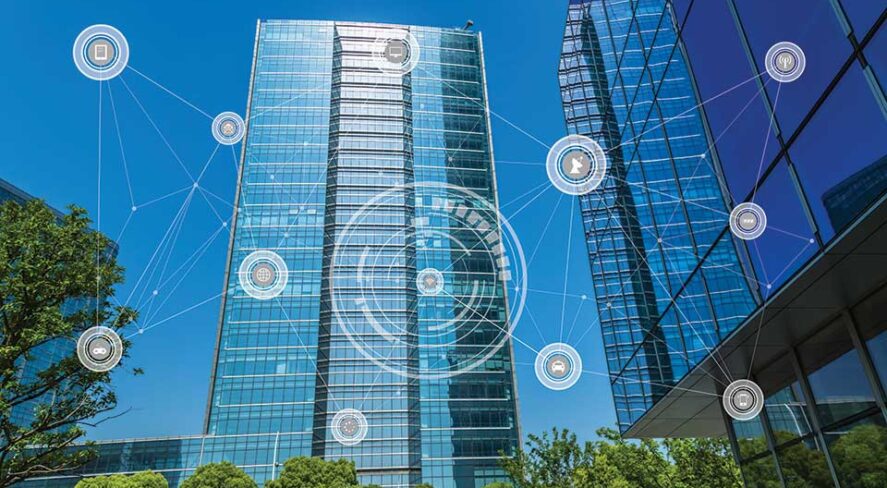Security Installations in a Wireless World

Wesco’s Bill Geary Discusses How Smart Buildings Demand a Future-Ready Infrastructure

In recent years, building infrastructure has been redefined to include communication systems and broadband networks, with cabling playing as important a role in the foundation of a building as concrete and plumbing. Smart buildings and the Internet of Things (IoT), along with connected devices that deliver improvements and advances in the workplace, have accelerated this redefinition of what infrastructure entails.
Always-on connectivity is required to provide the benefits of smart buildings and IoT enablement, and without a future-ready infrastructure, a building simply cannot operate at maximum efficiency. Further, the pace of technological advancements is increasing the number of devices and the amount of data and power needed to make it all work. With technology outpacing every other life cycle in the built environment, the cost of technology refreshes far outstrips the initial investment in high-performance infrastructure.
Smart buildings are no longer a trend, they are an expectation. In commercial buildings, IoT improves the operation of environmental controls, lighting, safety and security – all of which have an impact on sustainability initiatives. And the development of the connected ceiling has led to an entire ecosystem directly above that enables not just lighting, but also access points and a multitude of devices.
Another element to consider is that standards development is not keeping pace with smart building technology. There is a direct correlation between the increase in connectivity demands and the need for beyond-standards verification. The Communications Cable and Connectivity Association recently published a white paper on the need to measure beyond-standards performance. It calls out the trends requiring a verifiable testing capability that will eventually create new standards for cabling installations.
Considering technology refreshes on networking gear, the emergence of IoT in the workplace, and the continued explosion of demand for technology at the edge, there is a clear need for a robust foundational layer that can support the growth and operation of these building subsystems. The inevitable conclusion is that, for a relatively small increase in upfront investment, clients will have an infrastructure capable of supporting escalating bandwidth needs through multiple generations of technology, without having to replace their cabling infrastructure in the middle of its lifecycle. This, ultimately, saves money on the cost of future upgrades.
Technological advances in the development of the mobile phone illustrate this. Just 20 years ago, the capabilities of a phone were limited to calls and rudimentary texting. But, on June 29, 2007, all that changed. The iPhone made a cellphone smart, with photos, video, and an entire cottage industry of applications. Something similar can be said of buildings where applications in both IT and OT are joined together on a common network.
With this convergence of trends, there are new capabilities and expectations that require a new way of looking at infrastructure and its importance to every element of operations, including security, within the commercial building. Technologies that are not even being considered today will be deemed essential tomorrow.
Evolution of Security in Commercial Buildings
Security solutions for commercial buildings have evolved from locks with keys and guards patrolling with dogs to access-controlled doors and camera surveillance. The 1990s brought two pivotal developments to the security industry: the creation of the first IP surveillance camera and the use of radio frequency identification for access control. With these innovations, building security could be managed from a central location, occupancy data could be collected and analyzed, and better processes for emergencies within the facility could be developed. Additionally, these inventions became catalysts for other advances in physical security, such as server-based networking and data management, as well as video management systems shifting to video analytics.
Since 2000 – and mostly in the past 15 years – there has been an increase in new technologies and systems to support the many needs of commercial buildings, and with it, a more urgent requirement for fail-proof infrastructure. For example, the traditional surveillance camera started as CCTV, evolved to recordings and better optics and ultimately become a sensor platform offering numerous applications, including condition monitoring, productivity data, safety and even facial recognition.
The most recent development in the evolution of commercial building security comes from the connected ceiling – or digital ceiling – that utilizes the lighting network. Adding sensors to HVAC and other systems makes the workplace more comfortable for employees and guests, while delivering energy efficiency. The open access and flexibility of a ceiling’s design also makes it effective as a digital space. The addition of new or upgraded devices like wireless access points and ceiling cameras is relatively easy compared to the difficulties of installing behind walls.
With the rising number of connected systems on a network and their increasing importance in building security, it is essential for the cabling that keeps them all running to provide reliable performance and scalability.
Power Requirements for Commercial Buildings
Security installations are among many technology evolutions underway. But there is one common element to all of these technologies: they need electrical power. A building and its subsystems and applications can be powered in a number of ways, and the alphabet soup of choices is growing. DC, AC, PoE, FMP, SPE plus the associated cabling selections for fiber, copper and hybrid, are among the options, with the central considerations for installers being integration simplification and craft friendliness.
The current recommendation for a smart building that checks the boxes for installation simplification and ease of use and maintenance for end users is power over Ethernet (PoE). With a structure that can deliver both power and data over a single cable, PoE is increasingly the power system of choice for state-of-the-art commercial buildings. However, designers and decision makers may not be fully aware of PoE capabilities.
PoE is increasingly helpful for security installers who want to expand their capabilities, as well as scale operations to include installation of various endpoint devices in order to increase overall market share. The convergence of IT/OT applications and additional low-voltage installations provide security installers with the ability to grow their businesses with increased capabilities in low-voltage products and solutions.
Going Past 100 Meters
Not long ago, the commercial building industry was excited about the possibilities presented by smart buildings, but it was not prepared to take advantage of the benefits. Digital transformation, IoT and IT/OT convergence were all buzzwords and good ideas, but they were something for the future. Now, digital transformation and IoT are top of mind for nearly every organization, regardless of industry or market. And as IoT enablement and digitalization takes hold, IT/OT convergence will continue to be a top priority.
The CCCA pointed out the need for extended cabling distance measurements and standards: “We are seeing movement in creating extended distance standards, which will help eliminate confusion in the marketplace and prevent manufacturers from making marketing claims without the testing to back them up.”
Though there are some striking claims around extended distance and performance, they are not rigorously tested by unbiased third parties, and they are not the same as achieving validation, verification or testing and measurement that can equate to a standard. The CCCA whitepaper goes on to say, “Anyone looking to extend the distance of twisted-pair copper cabling beyond 100 meters should talk to their cabling manufacturer and ask the right questions to verify performance before investing. If marketing claims appear farfetched, look to reputable cable manufacturers that stand by empirical evidence and warranty their cables for applications and power levels to realistic distances.”
Options for Extended Reach
With extended reach solutions in demand and standards bodies showing interest in developing new requirements, how can installers drive future-readiness now and ensure a quality installation? There are a handful of measures that can be implemented to run a network beyond 100 meters and increase the number of endpoint devices served by the infrastructure.
Adding a telecommunications room (TR) closet is one way to ensure that devices have the power and bandwidth needed to operate while staying at or below the 100-meter distance limitation. These are relatively small, localized network closets or rooms with switches and network gear that extend connectivity to the areas of a building beyond the 100-meter mark. It is the most expensive option for extending reach in a commercial building.
Using an extender is another way to move network distances beyond 100 meters. They are more cost effective than TRs, but they require a power supply on both ends. When connecting to multiple devices, a switch is also needed at the device end.
All of the factors mentioned above – infrastructure, power, standards and extended distance – are underpinned by one thing: performance. Infrastructure needs to perform at a certain level, which is why standards were created. Every power source is measured by performance factors and is subject to standards. Now, standards performance testing is needed to validate solutions that extend networks beyond 100 meters.
As CCCA noted, “It wasn’t long ago that we saw cabling standards established, and now the industry simply wouldn’t operate without them. While industry standards do not currently address extended-distance deployments due to all the variables, there is light at the end of the tunnel. Collaborative efforts between several cable manufacturers, standards bodies and distributors are already helping to establish verified methods of measurement that guarantee results and protect design intent for extended reach, standards-based installations.”
All of this highlights the importance of security integrators staying up to date on current and upcoming trends. The demands on infrastructure related to distance, bandwidth and number of endpoint devices, combined with developments in power and technology, are enabling more and more low-voltage installations that once required a specialist but can now be included with other endpoint device and sensor installations. For the well-informed security installer, this can offer the opportunity to grow a business with not only more cameras, but also increased capabilities across the technology stack supported by a future-ready infrastructure.
